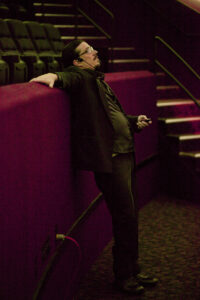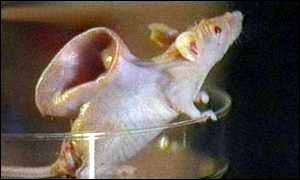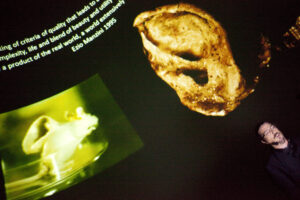By Shawna Lipton
The 26th Annual Meeting of the Society for Literature, Science, and the Arts (SLSA) themed NONHUMAN was held in Milwaukee, Sept 27-30, 2012.

Keynote speaker Oron Catts delivered an address in the domed IMAX theatre of the Milwaukee Public Museum titled “The Semi Living (as a nonhuman) Experience.” Catts is affiliated with several international research centers and artistic groups including the Tissue Culture and Art Project (Tcaproject.org), SymbioticA, and BiofiliA.
The Australian art research group SymbioticA produces flesh sculptures separate from human bodies. In its Tissue Culture and Art Project, the group uses recent medical research into growing human tissue for artistic rather than medical purposes. SymbioticA describes its sculptures as “still in the realm of the symbolic gesture representing a new class of object/being. These objects are partly artificially constructed and partly grown/born. They consist of both synthetic materials and living biological matter from complex organisms.” While medical researchers have to justify their interest in tissue growth by demonstrating the potential for their research to improve the quality of human life, the Tissue Culture and Art Project creates a complex set of ethical problems by growing tissue “sculptures” for art’s sake.

Catts discussed how tissue engineering, primarily used in regenerative biology and medicine has caused a conceptual shift in how we view the body. The body morphs into a biological machine, a machine that you can grow. SymbioticA’s experiments with semi-living products turn living tissues into a medium of artistic expression. Unlike traditional research groups, Catts’s work centers on questions not functions, seeking problems not solving them.

Two key examples of Catts’ s “semi-living sculptures” are In Vitro Meat: Disembodied Cuisine (2001-2003) and The Victimless Utopia (2004-2009). In Vitro Meat was an attempt to “grow” a steak, but the result was completely inedible. When they developed a version that was safe to consume it was so repellent that diners sampling it in a museum setting promptly spit it back out. Catts’s response was to display the chewed remains, creating a spectacle of his “failure.” This typifies how Catts’s artistic approach allows him to accept failure as a productive means of generating questions and problematics, rather than trying to “solve” the problem of producing a more sustainable form of meat in a laboratory. The Victimless Utopia project was a similar experiment to produce “Victimless Leather” out of a co-culture of mouse and human cells. The prototype of a “stitch-less” jacket grown in a technoscientific “body” proved to be unsustainable; its artificial body had to be unplugged at some point while it was displayed in the gallery. The fact that the jacket could not be kept “alive” once it was installed in the Moma lead to headlines that the sculpture had been “murdered” and art had been “killed”. Both projects-steak you can’t eat- victimless leather that must be killed – flaunt failure and problematize the responsibility we have toward man-made systems.

Catts revels in the loss of control over the living systems that he and his colleagues manipulate. The failure of these experiments illustrates that all scientific research is produced by the consumption of resources, even if their end game is to contribute to environmental causes or sustainability. Catts claims that each of his sculptures is an excessive luxury item-not intended for saving the world. Thus In Vitro Meat and Victimless Leather both exhibit the excessiveness of technology.
There is also a distinct connection between Catts’s post humanism and Queer Theory. Critic Jack Halberstam of the University of Southern California wrote about SymbioticA in his 2005 book In a Queer Time and Place: Transgender Bodies, Subcultural Lives: “Like the transgender person who may desire body modifications without desiring sex reassignment, the tissue sculptures produce spare body parts with no practical use and they eschew the logic of the perfectible body offering instead the body, as mutant form.” One SymbioticA project in particular participates in what Halberstam calls a “transgender aesthetic”. The Art(ificial) Womb uses an external womb to grow a set of semi-living dolls made of degradable polymers and surgical sutures. SymbioticA claim, “The artificial womb located outside of the body (equally separate from the male and female bodies) will be where the act of procreation occurs… We might be able to physically (and mentally) free ourselves from the ‘natural’ binary constraints of sex to create new forms and new plays.” Futility and failure are productive and revelatory for both Catts and Halberstam, creating new narratives about human life, culture, and technology.
SymbioticA are not trying to solve problems, they embrace failure over utility in order to examine the problems of technologies. In Catts’s words, “art is the last bastion of futility.” Catts and his fellow artists are aided by technologists who enjoy working with them because it is the only place they can do pure curiosity based research that is destined to fail. Catts’s philosophy of subversion and using art to reflect a twisted mirror back onto culture, as well as his celebration of futility, resonate with the themes of this year’s Midwest Interdisciplinary Graduate conference on Failure. The MIGC keynote speaker will be Jack Halberstam, author of The Queer Art of Failure.
MIGC 2013 (themigc@gmail.com) is currently seeking graduate students who want to further interrogate the concept of failure, its productive, troubling, and subversive aspects. We hope to explore questions such as:
How might we rethink failure as an opportunity to engage in more ethical human and nonhuman relationships? Can the failures of democracy, the economy, the classroom, and of culture more broadly open up possibilities for success? How do we recognize our fallibility, learn from it, and cope with it?
The deadline to submit to The Midwest Interdisciplinary Graduate Conference (MIGC) is December 1, 2012. The conference will be held in conjunction with The Center for 21st Century Studies at the University of Wisconsin-Milwaukee February 15 and 16, 2013.
[Shawna Lipton is a Ph.D. student in UWM’s English department, and the coordinator of MIGC. She is working on a dissertation on queer theory and the modernist author]






